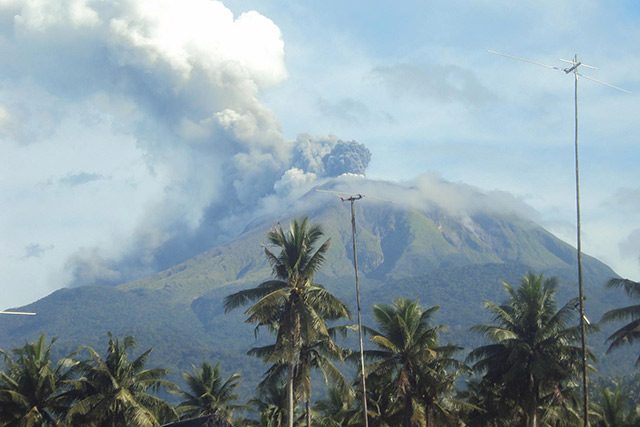SUMMARY
This is AI generated summarization, which may have errors. For context, always refer to the full article.

ALBAY, Philippines – Mount Bulusan in the neighboring province of Sorsogon exploded on Friday morning, May 1, spewing steam and ash for 5 minutes, seismic records showed.
Ed Laguerta, resident volcanologist of the Philippine Institute of Volcanology and Seismology (Phivolcs) in the Bicol region, said the ash explosion, which started at 8:09 am, drifted toward the villages of Puting Sapa and Sangayon in Juban town, and in the villages of Cogon, Gulang-Gulang, and Tinampo in Irosin town.
Bulusan is one of the most active volcanoes in the Philippines. It last erupted in 2011.
“This is just a minor explosion, which coincided with Labor Day celebration. We’re closely monitoring the activity if it will escalate in the coming days,” Laguerta said.
The explosion was initially not visible from a distance given the thick rain clouds that covered the summit. At around 10:30 am, when the skies cleared up, strong to moderate, dirty white steam was observed. It reached 200 meters high and drifted west-northwest coming from the northwest vent of the volcano.
The Bulusan seismic networ detected 5 volcanic earthquakes the past week. After the steam and ash explosion on Friday, the network recorded approximately 40 volcanic earthquakes.
While Phivolcs have yet to raise alert over Bulusan Volcano, local government units and the public are reminded that entry to the 4-kilometer radius Permanent Danger Zone (PDZ) is strictly prohibited due to the possibility of sudden and hazardous steam-driven or phreatic eruptions.
Phivolcs officials also warned people living within valleys and along rivers and stream channels should be vigilant against sediment-laden stream flows and lahars in the event of heavy and prolonged rainfall.
Civil aviation authorities have been told to advise pilots to avoid flying close to the volcano’s summit, as any sudden phreatic eruption could eject materials that are hazardous to aircraft. – Rappler.com
Add a comment
How does this make you feel?
There are no comments yet. Add your comment to start the conversation.